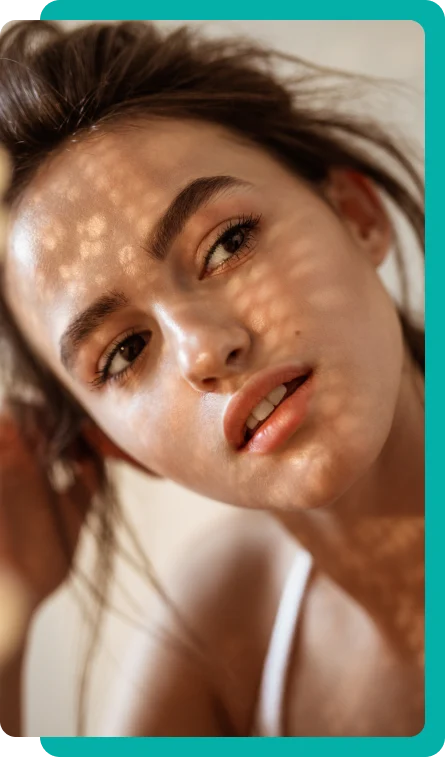For Patients
About
For Providers
Locations
Blog
Contact
Menu
Achieving an enhanced yet natural look using eye fillers requires an in-depth understanding of facial anatomy on the part of both patient and provider. When an eye filler is improperly placed, it can potentially exaggerate issues like under-eye hollowness instead of correcting them.
So how exactly does facial structure impact filler results, and what causes that sunken, sleep-deprived look after cheek injections? Let's analyze the relationship between dermal fillers and facial anatomy.

As we age, the fat pads in the cheeks naturally diminish due to thinning of the overlying soft tissue. This loss of volume in the mid-face area allows the formation of tear troughs, which are the hollows or dark circles beneath the lower eyelids.
Certain individuals may be more prone to this hollowing effect over time based on their underlying bone structure. Those with naturally thinner lower eyelid skin or less substantial cheek fat pads are likely to show signs of tear troughs sooner as their face loses support.
The right facial anatomy is key for dermal filler success in the mid-face. Attempting to plump deflated cheeks with injections can potentially draw more attention to a sunken under-eye area if the structural foundations are lacking.
While injecting filler into the cheek area may seem like an easy solution for restoring volume, the placement of the filler is critical.
If dermal filler is too superficially placed in the upper cheek, it can sometimes slide down towards the under-eye hollows. Deeper placement under the cheekbone is preferred to provide a lift. However, even this technique takes practice and precision.
Injecting fillers too deep along the cheekbone can further accentuate tear trough hollows if the filler over-augments the cheeks without addressing the under-eye area. The key is balance. An experienced injector will carefully place filler to gently restore cheek volume while also considering the lower eyelids.
When performed properly, cheek fillers can actually minimize dark circles and bags by providing support to lift and smooth the texture of the under-eye region. The filler should not migrate significantly once injected at the appropriate depth.
Not all eye filler treatments are created equal when it comes to facial rejuvenation. The consistency of the filler gel and its ability to integrate with the skin tissue plays a large role in achieving natural-looking, longer-lasting results.
Hyaluronic acid fillers are a popular choice for restoring lost volume in the cheek area. Products like Juvederm Voluma and Restylane Lyft contain higher concentrations of hyaluronic acid to offer substantial lift. Since these thicker fillers are made to last, they are less likely to migrate from the injection site.
Thinner hyaluronic acid fillers, such as Juvederm Ultra or Restylane Silk, may not provide enough lift for dramatic cheek augmentation. Because the gels are more fluid, they also tend to diffuse into the surrounding tissue more rapidly.
For mild cheek hollowness correction combined with under-eye rejuvenation, a qualified injector may strategically use both thicker and thinner fillers based on each area's needs.
Dermal filler placement is not the only factor that can potentially contribute to a hollow under-eye appearance. Elements like bruising, swelling, weight loss, and loss of facial fat can also come into play.
It's normal to experience some bruising and swelling for the first few days following cheek injections. As this dissipates, some patients are surprised to see under-eye hollowness persisting. Keep in mind that temporary post-procedure swelling can accentuate tear troughs before settling.
Loss of facial fat from aging or weight loss is another key culprit. Even if filler augments the cheeks optimally, overall fat loss in the face can still cause under-eye hollows to become more noticeable over time.
The takeaway is that filler results will not fully withstand age-related fat depletion. Some maintenance with additional injections is required.
If your eyes look more hollow after getting cheek fillers, don't worry! There are ways to fix this. Remember, everyone's face is different, so talk to an experienced cosmetic doctor about the best options for you.
Solutions:

Education about dermal fillers should be tailored based on one's familiarity with cosmetic procedures. This helps set appropriate expectations.
For filler first-timers, information about facial anatomy, how fillers are administered, and side effects like temporary swelling and bruising would be most beneficial. This group also needs to understand that fat loss impacts results.
Those who have previously had fillers likely want to focus on correction. Discussing filler adjustments, adding volume to the tear troughs, and the role of surgical procedures would suit this audience.
Future filler patients should learn about choosing an injector, communicating goals effectively during consultations, and how their unique facial structures impact options. Prevention is ideal.
With meticulous technique, a robust understanding of facial anatomy, and effective patient communication by a skilled injector, dermal filler procedures can expertly restore youthful contours without exaggerating under-eye hollowness.

Join Dr. Lanna & Dr. Doshi for a Transformation
Unlock the possibilities with our certified facial and oculofacial plastic surgeries. Attend our free webinar to find out how we can tailor solutions for you, with financing available to fit your budget.
